At one point or another most goat owners will need to give a copper bolus to their goats. Here’s how to administer a copper bolus to goats the easy way!
Copper deficiency in goats is very common and can cause all sorts of health problems if left untreated.
This site contains affiliate links. If you make a purchase using one of these links, I may earn a commission. Please see my disclosure page for more information about cookies collected and our privacy policy.
We live in an area that is pretty deficient in copper amounts in the soil, which means loose minerals aren’t enough when it comes to copper for the goats. They need additional copper in the form of a bolus 3-4 times a year.
Over the years we’ve tried a number of ways to get the boluses into the goats. We’ve tried mixing them into their herbal de-worming balls. We tried mixing them into bread and marshmallows. We tried cutting off the end of syringe and mixing it with something like probios and shooting it into their mouths. None of these were particularly successful.
The thing is, you have to get those copper rods WAY down their throats to keep the goats from chewing them. This means the goat will fight you and your fingers will have to also be way down their throats. And I don’t know about you, but those back teeth are sharp and speaking from experience, I don’t want my fingers anywhere near them!
Therefore, the easiest way to copper bolus a goat- is just to get it as far down their throat, using something other than your fingers, and force them to take it!
But before we get to that, let’s talk a little about copper deficiency…
Signs that you Need to Copper Bolus Your Goat:
- Wiry or rough coat
- Faded, sun-bleached appearance to their coat. This is especially noticeable in black goats
- Bald tip or “fish-tail” look to their tail
- High worm load or having a hard time fighting off parasites
Basically, if your goat looks a bit scruffy, seems to need constant worming, maybe showing signs of anemia. You probably need to address copper deficiency.
Related Reading: How to Diagnose and Treat Anemia in Goats
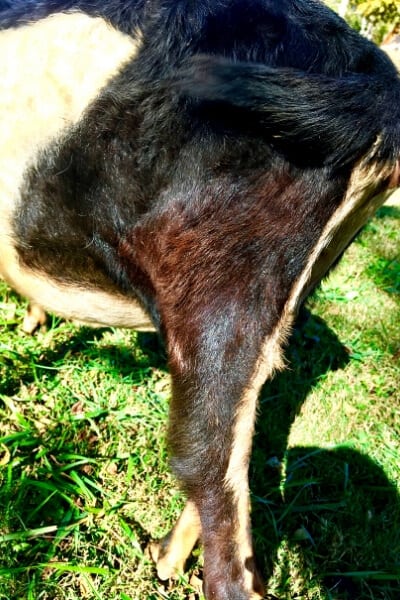
rust colored hair is a sign of copper deficiency
How to Copper Bolus a Goat (Using a Bolus Gun)
This is a pretty simple process. You will need 2 people- one to hold the goat and one to insert the copper bolus into their mouth. Or you can put your goat on the milk stand.
If you are new to goats, I recommend reading up as much as you can before you purchase. You can find a lot of articles here on The Free Range Life that will teach you about goat care and be sure to check out The Busy Homesteader’s Goat Management Binder– it’s full of to-do lists, checklists, record keeping sheets, and resource pages that will get your new goat herd off to a great start!
Supplies to give your goats a copper bolus:
- Copper Bolus capsules. You can use Ultra Cruz for Goats or Copasure. Copasure is dosed for cows, so you would have to open up the capsules and measure out the correct amount. We used Copasure for years because it was the only thing available, but the Ultra Cruz makes things simpler.
- A bolus gun
- Something sticky- like peanut butter, selenium/Vitamin E gel, or Probios– this will help ensure the capsule doesn’t fall out of the bolus gun to early and it helps the capsule stick in the rumen so that it has time to dissolve and allow the rods to go where they are supposed to go.
To get ready, place a little bit of your peanut butter or gel in the bolus gun and place a capsule down on top of it.
Then all you need to do is pull out the goat you are dosing so that the others don’t get all up in your face trying to steal your peanut butter or other supplies.
If you are not using a milk stand, have one person hold the goat’s head tightly with it tilted upwards and pry open their mouths. Straddling is the best way to do this- unless you are dealing with a goat with horns.
As soon as the goat’s mouth is open, shove the bolus gun as far back as possible. Really, really far. So far you think you will hurt them or choke them.
Then press the capsule in, remove the bolus gun and hold the goat’s mouth shut until you hear them swallow. You want to make sure that they swallow and not chew the capsule so that the rods stay the correct length and release copper over the next few months as expected.
Related Reading: Why Your Goats Need B Vitamins
That’s all there is too it! Much easier than coaxing them to eat a copper rod filled treats or getting your fingers bitten while trying to prevent them from chewing said treats.
Release them back into their yard and don’t feed them for a few hours so that the rods have time set before they get their rumen moving. (It’s not the end of the world if you do feed them after, no need to redose!)
Copper Bolus FAQ
What is the dosage for copper for goats?
The dosage for copper is approximately 4 grams per 100 lbs. Though some give copper at the rate of 1 gm per 22 lbs- which would be closer to 4.5 gm per 100 lbs.
I currently use Ultra Cruz copper boluses for goats which are pre-measured capsules of 4 gm per adult and 2 gm for (older) kids.
Is there a bolus gun available specifically for goats?
So far I haven’t been able to find one, but the market is constantly changing.
I use a small calf bolus gun and then use the probios or peanut butter to help it stick, since the bolus capsule is too small for the syringe.
What happens if the goat chews the capsule?
It’s not ideal, but it’s okay if this happens. The copper rods are a specific size so they stick in the stomach for a slow release of copper. if the goat chews the rods, some will be smaller and have a chance of passing straight through the goat.
You don’t need to redo the bolus, they will still get benefits from the bolus, it just may not last as long.
This article is for informational purposes only. All information is based on my own experience and research. Talk to your vet if you have any concerns with your goat or goat’s health.

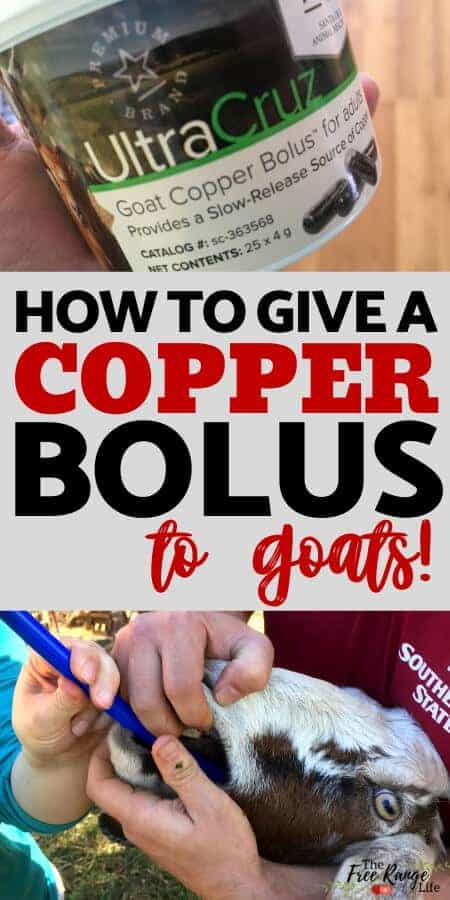
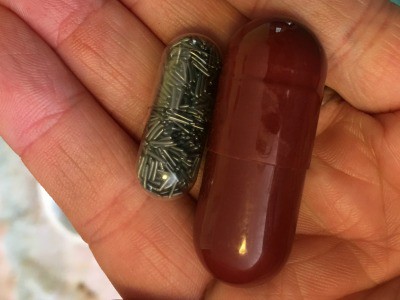
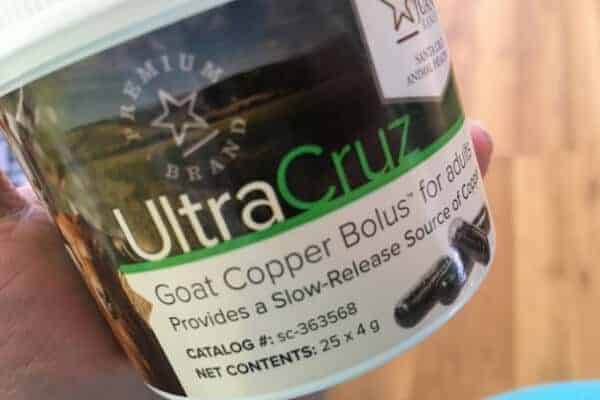
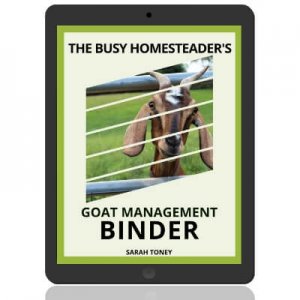

I am wondering why it is a problem if they chew them – I would be doing it for copper supplement, not deworming, so I am wondering if it is maybe dangerous for them to absorb it too fast? Or does it really matter if I am not trying to deworm?
The copper rods are meant to be slow release. If they chew the rods you increase the chances of the majority of the copper passing through and not sticking in the folds of the stomach. Meaning you would essentially be wasting the copper and have to bolus more frequently. This kind of copper works by sticking into the folds of the stomach and the goat slowly absorbs copper from them. It’s not the same as a copper supplement that is immediately metabolized.
If my goat chews them. Should I immediately dose them again? I have a black goat and he’s turning copper colored. We dosed him last week but he’s still changing color. Should I dose again?
Giving copper won’t reverse the bleaching of the hair. Expect to see a gradual change in color in 2 – 3 months, as they shed out the old bleached hair, and grow in new hair.
Nigers, Is there a chart for dosing Nigerian Dwarfs? They are 7 weeks. They are bottle fed still. Truth is part of me wants to feed them in the AM forever!!! I guess it’s the time I spend with them and hold and cuddle them. Thanks for your info, I need to start a binder of what to do when. there is a lot!
I have gathered a lot of supplies, and now I have to start using them.
The Goat Managment Binder she created is AMAZING!! It has checklists of all the necessary vaccines, supplements, dosage amounts and even routine care like hoof trimming on weekly, monthly, annual basis!! Worth the buy and not expensive at all!!
Hello We gave our goats the copper bolous tonight. My step mom gave them their milk bottles right after. So after reading the above comments. I guessing I’m going to have to re dose them again soon ?
Thanks for all of the good information, I have two young male goats , we got them from the sale barn when they were bottle babies, they are weaned now I am a first time goat owner so I don’t know much about goats, I love these little guys and want to do right for them thank you, Darla M.
I have bought 2 dwarf goats, 12 months old now, I have been putting copper pipes in the drinking water since they were 7 weeks old, but I haven’t even thought of adding copper bolous as a supplement, or even if you can purchase this in Australia
This was soo informative, thank you so much for this explosive infornatiin, im new in goat breeding!
How often do I need to dose with copper? What if they have enough in their system already? Will they become toxic?
How would you know if it’s going into the throat and not the windpipe?
I too have wondered if the copper rods would stick in mouth an throat and be an irritate?